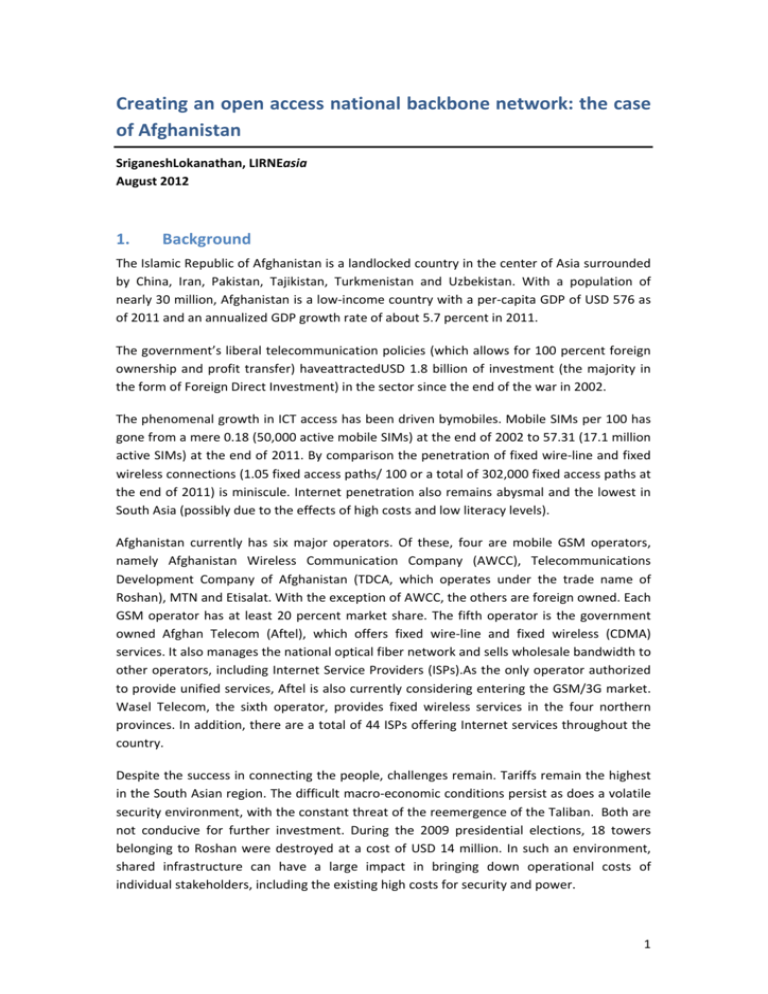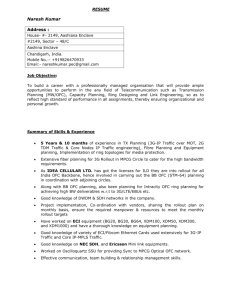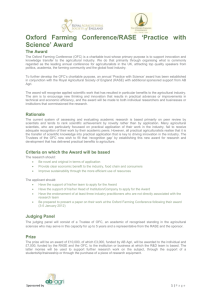Creating an open access national backbone network: the case of
advertisement

Creating an open access national backbone network: the case of Afghanistan SriganeshLokanathan, LIRNEasia August 2012 1. Background The Islamic Republic of Afghanistan is a landlocked country in the center of Asia surrounded by China, Iran, Pakistan, Tajikistan, Turkmenistan and Uzbekistan. With a population of nearly 30 million, Afghanistan is a low‐income country with a per‐capita GDP of USD 576 as of 2011 and an annualized GDP growth rate of about 5.7 percent in 2011. The government’s liberal telecommunication policies (which allows for 100 percent foreign ownership and profit transfer) haveattractedUSD 1.8 billion of investment (the majority in the form of Foreign Direct Investment) in the sector since the end of the war in 2002. The phenomenal growth in ICT access has been driven bymobiles. Mobile SIMs per 100 has gone from a mere 0.18 (50,000 active mobile SIMs) at the end of 2002 to 57.31 (17.1 million active SIMs) at the end of 2011. By comparison the penetration of fixed wire‐line and fixed wireless connections (1.05 fixed access paths/ 100 or a total of 302,000 fixed access paths at the end of 2011) is miniscule. Internet penetration also remains abysmal and the lowest in South Asia (possibly due to the effects of high costs and low literacy levels). Afghanistan currently has six major operators. Of these, four are mobile GSM operators, namely Afghanistan Wireless Communication Company (AWCC), Telecommunications Development Company of Afghanistan (TDCA, which operates under the trade name of Roshan), MTN and Etisalat. With the exception of AWCC, the others are foreign owned. Each GSM operator has at least 20 percent market share. The fifth operator is the government owned Afghan Telecom (Aftel), which offers fixed wire‐line and fixed wireless (CDMA) services. It also manages the national optical fiber network and sells wholesale bandwidth to other operators, including Internet Service Providers (ISPs).As the only operator authorized to provide unified services, Aftel is also currently considering entering the GSM/3G market. Wasel Telecom, the sixth operator, provides fixed wireless services in the four northern provinces. In addition, there are a total of 44 ISPs offering Internet services throughout the country. Despite the success in connecting the people, challenges remain. Tariffs remain the highest in the South Asian region. The difficult macro‐economic conditions persist as does a volatile security environment, with the constant threat of the reemergence of the Taliban. Both are not conducive for further investment. During the 2009 presidential elections, 18 towers belonging to Roshan were destroyed at a cost of USD 14 million. In such an environment, shared infrastructure can have a large impact in bringing down operational costs of individual stakeholders, including the existing high costs for security and power. 1 2. National Optical Fiber Cable (OFC) Backbone Network The Afghan government is building the national Optical Fiber Cable (OFC) backbone ring network (upto STM‐64) that will connect all the provinces. Once complete the OFC backbone will span 4400km (2700kmof the original planned 3400km has so far been completed and an additional 1000km is planned). The World Bank is assisting with technical guidance and partial funding for the USD 130 million project. Work began in early 2007 and currently 12 provinces (of 34) are fully connected and a further 5 are partially connected. The OFC is already connected to Iran, Pakistan (2 links with a third being considered), Tajikistan and Uzbekistan. The two links to Turkmenistan should be completed and activated within 2012. The expansion of the network to the southern provinces of Logar, Paktia, Khost, and Paktika will be completed in 2012/13. The World Bank will be financing an additional 1004km of fiber over two links. The World Bank will be financing an additional central link (765km) that will connect Kabul to Herat, via Chagcharan and also have a spur to Daikundi. It will also finance a northeastern spur (239km) from Kunduz to Fayzabad, which will one day connect to China. Both of these should be completed within the next two years. Figure 1: Existing OFC network, expansion plans and future redundancy links Source: World Bank Error! Reference source not found. above shows the existing route for the OFC (green), the proposed extensions to the central and northeastern provinces (blue), as well as the proposed future links for network redundancy (in red). Detailed planning on the redundancy links is yet to begin. Aftel will manage the OFC and sell wholesale bandwidth access to other operators, ISPs, etc. 2 3. Open access policy 3.1. Rationale The impetus for the creation of an open access policy came from multiple fronts.The government wanted to ensure that all retail telecommunications providers would have access to critical infrastructure such as high‐speed fiber. The government appreciatedthat shared infrastructure could lower the overall investment requirements. Given the volatile security environment, shared infrastructure could enable the sharing (and thus the overall reduction) of the high security costs faced by operators in maintaining their infrastructure. Given that the OFC was to be managed by Aftel, market participants were concerned about the possibility of Aftel leveraging the OFC to engage in potential anti‐competitive behavior when Aftel is privatized. Hence market participants wanted a clear forward‐looking governance framework that could ensure equitable access to the OFC that would continue irrespective of the privatization of Aftel. The high levels of outside technical and financial assistance that the government receives on the sector (including the World Bank, ISAF, USFOR‐A and USAID amongst others) also played an important role in ensuring that the creation of a policy of open access remained high on the government agenda. After a multi‐stakeholder consultative process, the “Open Access Policy of the Afghanistan Ministry of Communications and Information Technology” (hereafter OAP) came into effect in July 2012. Whilst the primary focus of the OAP remains the National OFC backbone, there is interest in encouraging the creation and use of shared infrastructure based on open access principles beyond the OFC. As part of the earlier consultative process, there were recommendations on give duct access not just to other telecommunication operators, but also to other utilities such as water. 3.2. Principles The core principles of the OAP as applicable to the services provided by a government owned entity, owner of a critical asset or a dominant provider, are: Non‐discrimination: One customer cannot be discriminated against in relation to another. Any additional burden placed on the provider can be tackled through an appropriate pricing strategy, subject to conformance withall the OAP principles. Transparency: All contracts with customers have to be publically available to other market participants. In lieu of negotiating a new contract, a new buyer canalso opt into an existing contract between the provider and another customer but has to accept all the terms of the existing contract. Cost‐based pricing: the prices charged by the provider have to be cost‐based. The government will determine the appropriate return on investment for the provider rather than the market. 3 3.3. Implementation plan The OAP sets out an implementation timeline spanning four years spread over two stages.In the first stage (2012‐2014), the Afghanistan Telecommunication Regulatory Authority (ATRA) would conduct a cost study and define Quality of Service (QoS) parameters as part of the tariff plan. ATRA personnel would also undergo training on costing and benchmarking with an emphasis on the relationship between cost, QoS and price. Based on the studies conducted by ATRA at this stage, the Directorate of Planning will then determine an appropriate return on investment for Aftel’s fiber services. Aftelwould have to respond to all information requests from the regulator quickly and would also need to give a minimum of one year’s notice before changing any technical aspects of the OFC interfaces. During the second stage (2014‐2016), ATRA would periodically conduct a market structure analysis to ensure that open access to the OFC and other essential infrastructure is occurring as intended. Once a timetable is set forAftel’s privatization, ATRA will immediately commence proceedings to determine Significant‐Market‐Power (SMP) status for the privatized entity and any potential remedies that may be required to ensure a level playing field. Upon Aftel’s privatization, the Directorate of Planning will transfer the Cost of Capital, Rate of Return and Market Analysis groups into ATRA. At this point, ATRA will also consider tariffs for any remaining dark fiber and also for duct‐access. 3.4. Analysis of the OAP Implementing open access is a complex task. Beyond concerns such as signaling a stable and effective policy and regulatory environment (in the current context and more importantly in the future), there are myriad ways for a dominant player owning a critical infrastructure to abuse its position. Cognizant of this complexity the OAP outlines concrete actions against set timelines and attempts to directly address some of the difficulties. For example, given ATRA’s current limited technical capacity, the training of regulatory personnel in skills necessary for the implementation of the OAP has been included in the first stage.The OAP also balances the need for training, with the need for timeliness in implementation. Hence, the OAP states thatregulatory and policy decisions would be timely. This also enables the government to obtain outside expertise to ensure timeliness in implementation (though the OAP does not articulate this specifically). Conscious of market concerns after the privatization of Aftel, the OAP reiterates that Aftel will continue to be regulated like any other market participant and be forced to comply with OAP principles, irrespective of its ownership being private or government. Furthermore, when a timeline for Aftel’s privatization is established, ATRA can make additional decisions (afteranalysis) to ensure continuity of open access to the National OFC backbone. Specifically, these could include structural separation of the wholesale and retail business, limiting Aftel to only wholesale services, or limiting the type of retail fiber services it can offer. The OAP attempts limit the ability of Aftel to side step the OFC principles. For example Aftel cannot change the technical specifications of the OFC interfaces for other operators without atleast a year’s notice. 4 4. Conclusion Despite challenges, the Open Access Policy is a framework for governance of critical and shared infrastructure such as the National OFC backbone. The proof of its success will be its implementation, but by all estimates, current actions by the government suggest that progress is being made in a timely fashion. An open‐access OFC backbone can potentially offer significant revenues for Afghanistan. According to MCIT, the existing operational links of the OFC are already generating revenues of USD 55 million per month for the government as of March 2012. Both the Afghan government as well as the US consider that there is much that can be leveraged for the benefit of Afghanistan via the National OFC, vis‐à‐vis its unique geographic position in the Central Asian region. The OFC connects three major Internet routes, the Trans‐Siberian Fiber, Trans‐Euro/Asian Fiber and the SE‐ME‐WE‐4 undersea cable system (see Figure 2). By acting as a North‐South transit link between these cables Afghanistan could earn significant revenue from the tariffs on the transit traffic. For example, the transit traffic via the express route through Iraq (which currently provides an alternate route around the choke point in the Suez Canal), already generates USD 1.5 billion/ year for Iraq. According to the ISAF Telecom Advisory Team (TAT) a similar possibility exists for Afghanistan. According to ISAF TAT, Afghanistan could also offer ICT services for the Central Asian region such as providing a location for Google or Akamai to locate their servers when optimizing their traffic for the region. Figure 2: Afghanistan in relation to the main regional Internet routes Source: ISAF Telecom Advisory Team 5






